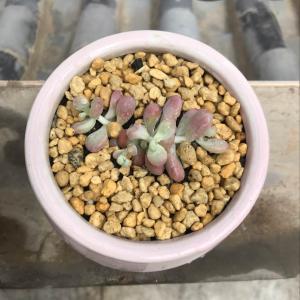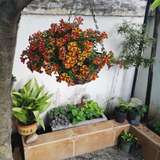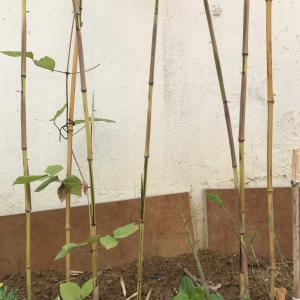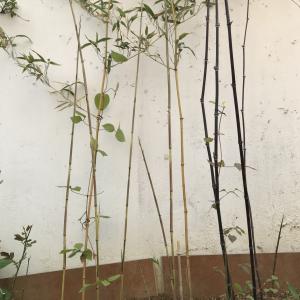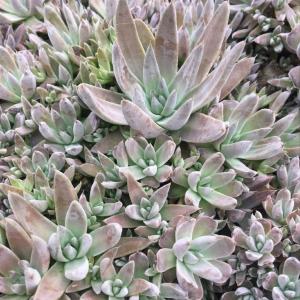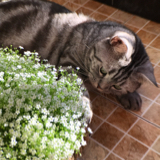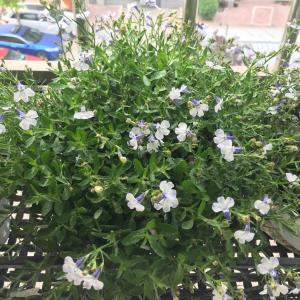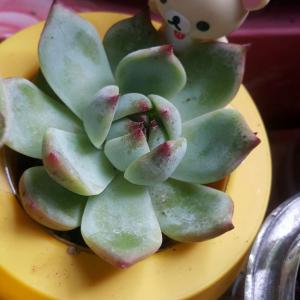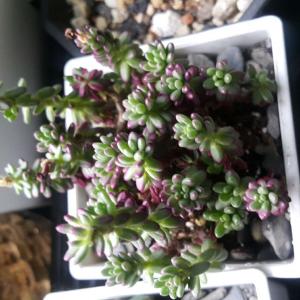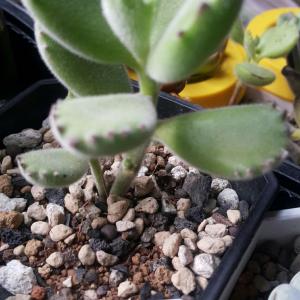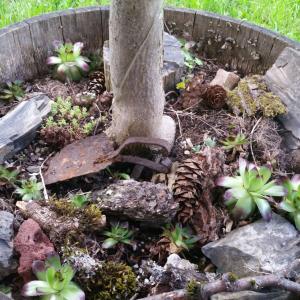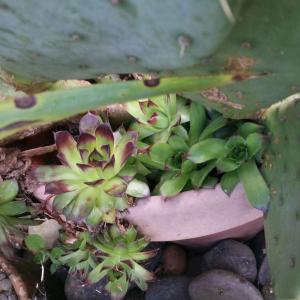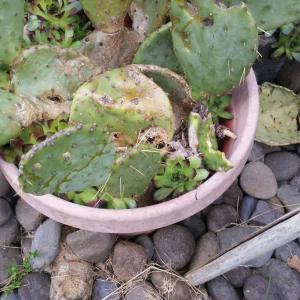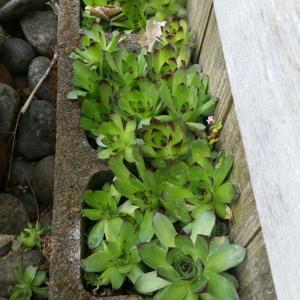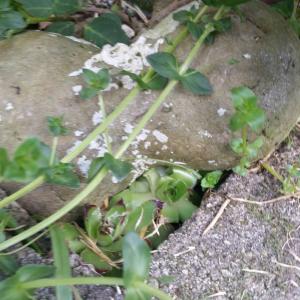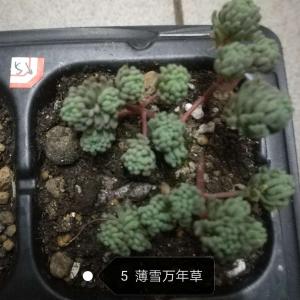文章
Miss Chen
2018年05月13日

Description: This small perennial orchid produces a low rosette of evergreen basal leaves. Individual leaves are 1½-2½" long and ¾-1½" across; they are ovate or broadly elliptic and smooth along their margins. There are 5-7 primary veins per leaf; they are parallel. These veins are interconnected through a network of secondary veins. Both the primary and secondary veins are accented in white, while the remaining leaf surface is dark green. The basal leaves taper abruptly to petiole-like bases that are short and winged, where they are also accented in white along their central veins. After several years, a spike-like raceme of flowers develops from the basal rosette that is 4-14" tall and more or less erect. The central stalk of this inflorescence is light green, glandular-pubescent, and terete. Along the lower two-thirds of its length, there are widely separated leafy bracts. These bracts are small in size (about ½" in length), linear-lanceolate in shape, and ascending to erect. Along the upper one-third of the central stalk, the small flowers are densely distributed, facing in all directions.
The sepals and petals of these flowers (3 of each per flower) are white or greenish white, while their inferior ovaries are green and glandular-pubescent. The upper sepal and 2 lateral petals of each flower are merged together to form a hood with a slightly upturned outer rim, while the 2 lateral sepals are free and the lower petal forms an open pouch with a minute down-turned beak. These petals and sepals are 3.5-5.5 mm. long; the outer surfaces of the hood and lateral sepals are minutely pubescent. The ovaries are 6-8 mm. long, ellipsoid in shape, and ascending. At the bases of the ovaries, there are ascending floral bracts. These bracts are green, glandular-pubescent, linear-lanceolate in shape, and ascending; they are about the same length as the ovaries. The blooming period occurs during mid- to late summer, lasting about 3-4 weeks. There is no noticeable floral fragrance. Afterwards, the flowers are replaced by seed capsules that become ovoid in shape and brown at maturity. At this time, these capsules split open into several sections to release their minute seeds to the wind. The root system consists of a shallow creeping rhizome with coarse fibrous roots. After flowering, this rhizome forms 1-3 clonal offsets. The clonal offsets become independent on their rhizomes, while the original rhizome dies. The evergreen basal leaves persist for at least 1½ years (at least 2 summers and 1 winter).

Cultivation: The preference is medium shade to dappled sunlight, mesic to dry-mesic conditions, and an acidic loose soil that contains loam, loess (wind-blown silt from a prior ice age), or glacial till with decaying organic matter. The site should be protected from drying winds and it should be relatively humid. The root system of this orchid benefits from an endomycorrhizal association with certain kinds of fungi. This orchid has been successfully cultivated indoors in terrariums (Ugiansky, 2010). It should not be collected from the wild, which can easily destroy local populations.
Range & Habitat: The native Downy Rattlesnake-Plantain is uncommon in Illinois, occurring mostly in northern and southern Illinois (see Distribution Map). Habitats include upland woodlands, north-facing wooded slopes, bluffs, large wooded ravines or sandstone canyons, sandstone glades, and woodlands damaged by logging. On rare occasions, this orchid has also been found in forested bogs. It is often associated with such canopy trees as oaks, pines, Eastern Hemlock (Tsuga canadensis), or sugar maple (Acer saccharum). This orchid usually occurs in high Faunal Associations: The small flowers are cross-pollinated by bees, including bumblebees (Bombus spp.) and green metallic bees (e.g., Augochlora spp., Augochlorella spp.); see ILPIN and Homoya (1993) for more information. Aside from this, little is known about floral-faunal relationships for this orchid. The evergreen leaves may be browsed by deer and the rhizomes may be eaten by chipmunks or mice, but additional study of such potential threats is required.
Photographic Location: A rocky bluff dominated by Eastern Hemlock (Tsuga canadensis) at a nature preserve in east-central Indiana.
Comments: While the flowers of Downy Rattlesnake-Plantain are rather small, the reticulated patterns of its basal leaves are very ornate and unique, making this orchid easy to identity. In spite of its common name, this orchid is not closely-related to plantains (Plantago spp.); its leaves have a shape that is similar to some of the common broad-leaved plantains. The common name is also inspired by the superficial resemblance of the leaves' reticulated patterns to the skin of a rattlesnake. The inflorescence of Downy Rattlesnake-Plantain resembles those of the Lady Tresses' Orchids (Spiranthes spp.), although they have dissimilar leaves. The flowers of the former orchid differ from those of the latter by the pouch-like structure of their lower lips, which is lacking in the flowers of Lady Tresses' Orchids. There are other orchid species in the Goodyera genus, but their ranges are located outside of Illinois, mostly to the north or northeast.
The sepals and petals of these flowers (3 of each per flower) are white or greenish white, while their inferior ovaries are green and glandular-pubescent. The upper sepal and 2 lateral petals of each flower are merged together to form a hood with a slightly upturned outer rim, while the 2 lateral sepals are free and the lower petal forms an open pouch with a minute down-turned beak. These petals and sepals are 3.5-5.5 mm. long; the outer surfaces of the hood and lateral sepals are minutely pubescent. The ovaries are 6-8 mm. long, ellipsoid in shape, and ascending. At the bases of the ovaries, there are ascending floral bracts. These bracts are green, glandular-pubescent, linear-lanceolate in shape, and ascending; they are about the same length as the ovaries. The blooming period occurs during mid- to late summer, lasting about 3-4 weeks. There is no noticeable floral fragrance. Afterwards, the flowers are replaced by seed capsules that become ovoid in shape and brown at maturity. At this time, these capsules split open into several sections to release their minute seeds to the wind. The root system consists of a shallow creeping rhizome with coarse fibrous roots. After flowering, this rhizome forms 1-3 clonal offsets. The clonal offsets become independent on their rhizomes, while the original rhizome dies. The evergreen basal leaves persist for at least 1½ years (at least 2 summers and 1 winter).

Cultivation: The preference is medium shade to dappled sunlight, mesic to dry-mesic conditions, and an acidic loose soil that contains loam, loess (wind-blown silt from a prior ice age), or glacial till with decaying organic matter. The site should be protected from drying winds and it should be relatively humid. The root system of this orchid benefits from an endomycorrhizal association with certain kinds of fungi. This orchid has been successfully cultivated indoors in terrariums (Ugiansky, 2010). It should not be collected from the wild, which can easily destroy local populations.
Range & Habitat: The native Downy Rattlesnake-Plantain is uncommon in Illinois, occurring mostly in northern and southern Illinois (see Distribution Map). Habitats include upland woodlands, north-facing wooded slopes, bluffs, large wooded ravines or sandstone canyons, sandstone glades, and woodlands damaged by logging. On rare occasions, this orchid has also been found in forested bogs. It is often associated with such canopy trees as oaks, pines, Eastern Hemlock (Tsuga canadensis), or sugar maple (Acer saccharum). This orchid usually occurs in high Faunal Associations: The small flowers are cross-pollinated by bees, including bumblebees (Bombus spp.) and green metallic bees (e.g., Augochlora spp., Augochlorella spp.); see ILPIN and Homoya (1993) for more information. Aside from this, little is known about floral-faunal relationships for this orchid. The evergreen leaves may be browsed by deer and the rhizomes may be eaten by chipmunks or mice, but additional study of such potential threats is required.
Photographic Location: A rocky bluff dominated by Eastern Hemlock (Tsuga canadensis) at a nature preserve in east-central Indiana.
Comments: While the flowers of Downy Rattlesnake-Plantain are rather small, the reticulated patterns of its basal leaves are very ornate and unique, making this orchid easy to identity. In spite of its common name, this orchid is not closely-related to plantains (Plantago spp.); its leaves have a shape that is similar to some of the common broad-leaved plantains. The common name is also inspired by the superficial resemblance of the leaves' reticulated patterns to the skin of a rattlesnake. The inflorescence of Downy Rattlesnake-Plantain resembles those of the Lady Tresses' Orchids (Spiranthes spp.), although they have dissimilar leaves. The flowers of the former orchid differ from those of the latter by the pouch-like structure of their lower lips, which is lacking in the flowers of Lady Tresses' Orchids. There are other orchid species in the Goodyera genus, but their ranges are located outside of Illinois, mostly to the north or northeast.
0
0
文章
Miss Chen
2018年05月12日

Description: This sub-shrub is 3–8" (5–20 cm.) tall. It has ascending semi-woody stems that are sparingly branched. These stems are light green to bright red and more or less terete; they are sparsely to moderately covered with appressed white hairs. Alternate evergreen leaves occur along these stems. The leaves are ¾–2" (2–5 cm.) long and about one-third to one-half as much across; they are elliptic, ovate, obovate, or oval in shape. The margins of the leaves are sparsely serrated with bristly teeth. The upper leaf surface is medium to dark green, hairless, and shiny, while the lower leaf surface is light green, hairless to sparsely appressed-hairy, and dull. Leaf texture is somewhat stiff and leathery, while leaf venation is pinnate. The petioles of the leaves are light green to bright red and less than ¼" (6 mm.) long; they are sparsely to moderately covered with appressed white hairs. The foliage of this sub-shrub has a minty (or wintergreen) fragrance, especially when it is crushed. Either solitary or short racemes of 2-5 nodding flowers develop from the upper leaf axils.
Each flower is about 1/3" (8 mm.) in length, consisting of a white bell-shaped corolla (sometimes tinted pink) with 5 short outwardly curled lobes, a white calyx with 5 ovate-oval lobes, 5 inserted stamens, and a pistil with a single stout style. The calyx is much shorter than the corolla. At the base of each flower, there is a pair of tiny ovate to heart-shaped bracts; these bracts can be light green, white, or red, and they have membranous margins. The pedicels of the flowers are up to 1/3" (8 mm.) in length, light green to red, and more or less terete; they are sparsely to moderately covered with appressed white hairs. The blooming period occurs from early to mid-summer, lasting about 3 weeks. The flowers are reported to be fragrant. Afterwards, fertile flowers are replaced by berry-like fruits that become mature during late summer or early autumn. Mature fruits are about 1/3" (8 mm.) or slightly more across, bright red, and globoid in shape; they have a fleshy interior that is slightly sweet and minty (wintergreen) in flavor. Each fruit contains many tiny seeds. The root system has shallow rhizomes, from which clonal subshrubs develop. The evergreen foliage becomes reddish or purplish during the autumn.

Cultivation: The preference is partial sun to light shade, moist to dry-mesic conditions, relatively cool temperatures, and somewhat acidic soil containing either sand or loam with decaying organic matter. Growth and development are relatively slow. Flowers and fruits are more likely to be produced in brighter locations. The seeds are difficult to germinate.
Range & Habitat: Wintergreen (Gaultheria procumbens) is native to northern Illinois, where it is rare and state-listed as 'endangered' (see Distribution Map). Elsewhere within the state, it is absent from natural areas. Wintergreen occurs primarily in the Great Lakes region, northeastern USA, and adjacent areas of Canada; it also occurs in the Appalachian mountains in high-altitude areas. In Illinois, the habitats of this sub-shrub are largely restricted to upland oak woodlands, wooded hillsides, forested bogs, and shrubby bogs. In more northern areas, it is often found in coniferous woodlands, mixed woodlands, and shrubby meadows. Wintergreen occurs in high quality natural areas in Illinois. It is easily topkilled by wildfires, although the thinning of the tree canopy and reduction of taller shrubs can cause populations of this sub-shrub to increase.

Faunal Associations: Bumblebees are the primary pollinators of the flowers. Other floral visitors include cuckoo bumblebees (Psithyrus spp.) and the honeybee. Nectar is the primary floral reward for these insect visitors (Mirick & Quin, 1981; Reader, 1977; Lovell, 1898). Other insects feed on the plant sap or foliage of Wintergreen (Gaultheria procumbens). These species include an aphid (Illinoia borealis) and larvae of two moths, Cameraria gaultheriella and Rhopobota naevana (Blackman & Eastop, 2013; Ferguson, 1975; Needham et al., 1928). Birds and mammals also use Wintergreen as a source of food. The Ruffed Grouse eats the buds, leaves, and fruits; the Bobwhite Quail, Ring-necked Pheasant, and the extinct Passenger Pigeon eat (or ate) the fruits (Bennetts, 1900; Martin et al., 1951/1961; Coladonato, 1994; Schorger, 1955). This sub-shrub provides protective cover for the nests of the rare Kirtland's Warbler in Jack Pine barrens in the state of Michigan (Buech, 1980). Mammals feeding on this sub-shrub include the American Black Bear (leaves & fruits), Red Fox (fruits), Eastern Chipmunk (leaves & fruits), Elk (leaves & twigs), White-tailed Deer (leaves & twigs), Deer Mouse (fruits), and White-footed Mouse (fruits); see Coladonato (1994), Martin et al. (1951/1961), Schneider et al. (2006), Hamilton (1941), and Schloyer (1976) for more information. Fruit-eating birds and mammals spread the seeds to new locations.

Photographic Location: A flower garden at the Urbana Free Library in Urbana, Illinois, and a wooded hillside at the Pine Hills Nature Preserve in west-central Indiana.
Comments: The most striking characteristic of this plant is the mint (or wintergreen) fragrance of its crushed leaves, from which oil of wintergreen is made. Even without flowers or fruits, Wintergreen (Gaultheria procumbens) can be identified by the size, shape, and fragrance of its leathery evergreen leaves. Another species in this genus, Creeping Snowberry (Gaultheria hispidula), is found north of Illinois in more boreal areas. Its crushed leaves have the same wintergreen fragrance, but Creeping Snowberry differs from Wintergreen by its prostrate habit of growth, white berry-like fruits, and smaller leaves. Other similar species in the Heath family (Ericaceae) are either larger shrubs or their leaves lack the wintergreen fragrance. Other common names of Gaultheria procumbens are Teaberry and Checkerberry.
Each flower is about 1/3" (8 mm.) in length, consisting of a white bell-shaped corolla (sometimes tinted pink) with 5 short outwardly curled lobes, a white calyx with 5 ovate-oval lobes, 5 inserted stamens, and a pistil with a single stout style. The calyx is much shorter than the corolla. At the base of each flower, there is a pair of tiny ovate to heart-shaped bracts; these bracts can be light green, white, or red, and they have membranous margins. The pedicels of the flowers are up to 1/3" (8 mm.) in length, light green to red, and more or less terete; they are sparsely to moderately covered with appressed white hairs. The blooming period occurs from early to mid-summer, lasting about 3 weeks. The flowers are reported to be fragrant. Afterwards, fertile flowers are replaced by berry-like fruits that become mature during late summer or early autumn. Mature fruits are about 1/3" (8 mm.) or slightly more across, bright red, and globoid in shape; they have a fleshy interior that is slightly sweet and minty (wintergreen) in flavor. Each fruit contains many tiny seeds. The root system has shallow rhizomes, from which clonal subshrubs develop. The evergreen foliage becomes reddish or purplish during the autumn.

Cultivation: The preference is partial sun to light shade, moist to dry-mesic conditions, relatively cool temperatures, and somewhat acidic soil containing either sand or loam with decaying organic matter. Growth and development are relatively slow. Flowers and fruits are more likely to be produced in brighter locations. The seeds are difficult to germinate.
Range & Habitat: Wintergreen (Gaultheria procumbens) is native to northern Illinois, where it is rare and state-listed as 'endangered' (see Distribution Map). Elsewhere within the state, it is absent from natural areas. Wintergreen occurs primarily in the Great Lakes region, northeastern USA, and adjacent areas of Canada; it also occurs in the Appalachian mountains in high-altitude areas. In Illinois, the habitats of this sub-shrub are largely restricted to upland oak woodlands, wooded hillsides, forested bogs, and shrubby bogs. In more northern areas, it is often found in coniferous woodlands, mixed woodlands, and shrubby meadows. Wintergreen occurs in high quality natural areas in Illinois. It is easily topkilled by wildfires, although the thinning of the tree canopy and reduction of taller shrubs can cause populations of this sub-shrub to increase.

Faunal Associations: Bumblebees are the primary pollinators of the flowers. Other floral visitors include cuckoo bumblebees (Psithyrus spp.) and the honeybee. Nectar is the primary floral reward for these insect visitors (Mirick & Quin, 1981; Reader, 1977; Lovell, 1898). Other insects feed on the plant sap or foliage of Wintergreen (Gaultheria procumbens). These species include an aphid (Illinoia borealis) and larvae of two moths, Cameraria gaultheriella and Rhopobota naevana (Blackman & Eastop, 2013; Ferguson, 1975; Needham et al., 1928). Birds and mammals also use Wintergreen as a source of food. The Ruffed Grouse eats the buds, leaves, and fruits; the Bobwhite Quail, Ring-necked Pheasant, and the extinct Passenger Pigeon eat (or ate) the fruits (Bennetts, 1900; Martin et al., 1951/1961; Coladonato, 1994; Schorger, 1955). This sub-shrub provides protective cover for the nests of the rare Kirtland's Warbler in Jack Pine barrens in the state of Michigan (Buech, 1980). Mammals feeding on this sub-shrub include the American Black Bear (leaves & fruits), Red Fox (fruits), Eastern Chipmunk (leaves & fruits), Elk (leaves & twigs), White-tailed Deer (leaves & twigs), Deer Mouse (fruits), and White-footed Mouse (fruits); see Coladonato (1994), Martin et al. (1951/1961), Schneider et al. (2006), Hamilton (1941), and Schloyer (1976) for more information. Fruit-eating birds and mammals spread the seeds to new locations.

Photographic Location: A flower garden at the Urbana Free Library in Urbana, Illinois, and a wooded hillside at the Pine Hills Nature Preserve in west-central Indiana.
Comments: The most striking characteristic of this plant is the mint (or wintergreen) fragrance of its crushed leaves, from which oil of wintergreen is made. Even without flowers or fruits, Wintergreen (Gaultheria procumbens) can be identified by the size, shape, and fragrance of its leathery evergreen leaves. Another species in this genus, Creeping Snowberry (Gaultheria hispidula), is found north of Illinois in more boreal areas. Its crushed leaves have the same wintergreen fragrance, but Creeping Snowberry differs from Wintergreen by its prostrate habit of growth, white berry-like fruits, and smaller leaves. Other similar species in the Heath family (Ericaceae) are either larger shrubs or their leaves lack the wintergreen fragrance. Other common names of Gaultheria procumbens are Teaberry and Checkerberry.
0
0





